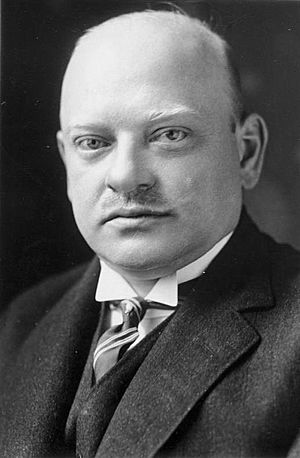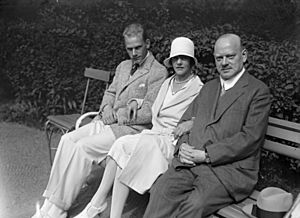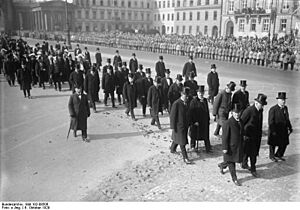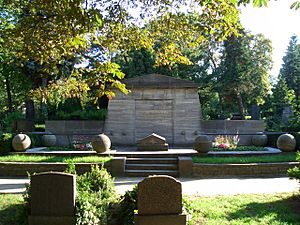Gustav Stresemann facts for kids
Quick facts for kids
Gustav Stresemann
|
|
|---|---|
 |
|
| Chancellor of Germany | |
| In office 13 August 13 1923 – 23 November 1923 |
|
| Preceded by | Wilhelm Cuno |
| Succeeded by | Wilhelm Marx |
| Foreign Minister and Chancellor | |
| In office 13 August 1923 – 23 November 1923 |
|
| Foreign Minister | |
| In office 23 November 1923 – 3 October 1929 |
|
| Personal details | |
| Born | 10 May 1878 |
| Died | October 3, 1929 (aged 51) |
| Political party | National Liberal Party (1907-1918) German Democratic Party (1918) German People's Party (1918-1929) |
Gustav Stresemann (born May 10, 1878 – died October 3, 1929) was an important German politician. He served as both Chancellor and Foreign Minister of Germany during the Weimar Republic. This was the period in German history between 1918 and 1933. He is remembered for helping Germany recover after World War I. In 1926, he was awarded the Nobel Peace Prize for his efforts to bring peace to Europe.
Gustav Stresemann is seen as one of Germany's most important leaders. He strongly supported democracy during a difficult time for Germany. He also believed in European countries working together economically. His biggest success was helping Germany and France become friends again. For this, he shared the Nobel Peace Prize with French politician Aristide Briand.
Contents
Early Life and Education
Gustav Stresemann was born on May 10, 1878, in Berlin, Germany. He was the youngest of seven children. His father worked with beer and also ran a small bar. Even though his family was not rich, they had enough money to give Gustav a good education.
Stresemann was a very good student. He especially loved German literature and poetry. After finishing school, he thought about becoming a teacher. However, he decided to study political economy at the University of Berlin in 1897. During his studies, he learned a lot about the political ideas of his time.
He also joined student groups called Burschenschaften. In 1898, he became the editor of a newspaper for these student groups. His articles often talked about politics. He combined ideas of freedom (liberalism) with strong national pride (nationalism). Later, he moved to the University of Leipzig to get his doctorate degree. In 1901, he finished his studies. His paper was about the bottled beer industry in Berlin.
Early Career and Political Journey
In 1902, Stresemann started the Saxon Manufacturers' Association. The next year, he married Käte Kleefeld, whose father was a rich Jewish businessman from Berlin. He also joined a political group called the National-Social Association. In 1906, he was elected to the Dresden town council.
Stresemann soon became a leader in the National Liberal Party in Saxony. In 1907, he was elected to the Reichstag, which was the German parliament. He became a close friend of the party leader, Ernst Bassermann. However, some members didn't like his ideas about social welfare programs. Because of this, he lost his position in the party in 1912. He also lost his seats in the Reichstag and town council that year.
He then worked in business and started the German-American Economic Association. In 1914, he returned to the Reichstag. He could not serve in the military during World War I because of his poor health. When Bassermann was away due to illness or military service, Stresemann became the unofficial leader of the National Liberals. After Bassermann died in 1917, Stresemann officially took over as party leader.
During World War I, Stresemann's political views changed. At first, he was on the left side of his party. But during the war, he became more conservative. He supported the German monarchy and Germany's goals to expand its power. He also supported using submarines to attack ships without warning. However, he still wanted to expand social welfare programs. He also supported allowing more people in Prussia to vote.
After the war, Germany had to accept the peace terms from the Allies. Stresemann briefly joined the German Democratic Party. But he was kicked out because of his ties to more conservative groups. He then formed the German People's Party (DVP). This party mostly got support from middle and upper-class Protestants. The DVP believed in Christian family values and non-religious education. They were also against communism and socialism.
At first, the DVP was seen as opposing the new Weimar Republic. They were slow to accept democracy. However, by late 1920, Stresemann started working with other parties. This might have been because of political murders, like that of Walther Rathenau. Even though he worked with the republic, he still believed in the monarchy in his heart.
Leading Germany in the Weimar Republic
On August 13, 1923, Gustav Stresemann became Chancellor and Foreign Minister of Germany. This was during a very difficult time called the Ruhr Crisis. As Chancellor, Stresemann worked hard to solve this crisis. In 1923, which was known as the "year of crises," he showed strong leadership. He stopped the peaceful resistance in the Ruhr region. This area was occupied by French and Belgian troops because Germany couldn't pay its war debts.
Because Germany was printing too much money to pay striking workers, the country faced hyperinflation. This meant money became almost worthless. Hans Luther, the finance minister, helped fix this by introducing a new currency called the Rentenmark. This helped people trust the government again.
Stresemann believed that Germany had to try its best to follow the Treaty of Versailles. This was the peace treaty signed after World War I. Most Germans, including Stresemann, felt the treaty was unfair and dishonored their country. But he thought that by trying to meet its terms, Germany could show that it truly could not afford the huge war payments. He also wanted to get the Rhineland back from foreign occupation.
However, some of his actions, like not dealing strongly with those involved in the Beer Hall Putsch, upset the Social Democrats. They left his government, and his coalition collapsed on November 23, 1923. Stresemann remained as Foreign Minister in the next government. He stayed in this role for the rest of his life, serving in eight different governments.
Foreign Policy Achievements
As Foreign Minister, Stresemann achieved many important things. His first big success was the Dawes Plan in 1924. This plan helped reduce Germany's war payments and reorganized its central bank.
He also worked on the Locarno Treaties in 1925. These agreements were signed with Britain, France, Italy, and Belgium. Germany officially accepted its western borders after World War I. It also promised not to invade Belgium and France again. In return, Germany was promised peace with France and was allowed to join the League of Nations. The last Allied troops also left the Rhineland.
Stresemann was not willing to make a similar treaty for Germany's eastern borders with Poland. He believed Germany should be able to change these borders peacefully later. He also wanted to improve relations with the Soviet Union. In April 1926, Germany signed the Treaty of Berlin. This agreement strengthened an earlier treaty with Russia.
In September 1926, Germany was accepted into the League of Nations as a permanent member. This showed that Germany was becoming a "normal" country again. Stresemann believed this would give Germany a stronger voice in international affairs. He shared the Nobel Peace Prize in 1926 for these achievements.
Germany also signed the Kellogg–Briand Pact in August 1928. This agreement meant that countries promised not to use violence to solve international problems. Germany's signing of this pact helped other countries trust the Weimar Republic more. This trust led to the Young Plan in 1929, which further reduced Germany's war payments.
Gustav Stresemann's success came from his friendly personality and his willingness to adapt. He became good friends with many important foreign leaders, especially Aristide Briand. Stresemann's main goal was to free Germany from the heavy burden of war payments. He wanted to build a strong economic partnership with the United States. This strategy worked very well until the Great Depression hit after his death.
Over time, Stresemann grew to accept the Weimar Republic more and more. Even though he had initially been against it, he helped make the young democracy stronger. He was seen as a "republican by reason." This meant he accepted the republic because it was the best option, even if he still preferred a monarchy in his heart. Some conservative politicians criticized him for supporting the republic and for trying to fulfill the demands of the Western powers.
Death and Legacy
Gustav Stresemann died from a stroke in October 1929. He was only 51 years old. His death, along with the deaths of other important European leaders like Aristide Briand, created a gap in European leadership. Many historians believe this made it harder to prevent World War II.
Gustav and Käthe Stresemann had two sons, Wolfgang and Joachim Stresemann.
Quotes
If the allies had obliged me just one single time, I would have brought the German people behind me, yes; even today, I could still get them to support me. However, they (the allies) gave me nothing and the minor concessions they made, always came too late. Thus, nothing else remains for us but brutal force. The future lies in the hands of the new generation. Moreover, they, the German youth, who we could have won for peace and reconstruction, we have lost. Herein lies my tragedy and their, the allies' crime.
—Stresemann, to diplomat Sir Albert Bruce Lockhart in 1929
Books
- Turner, Henry Ashby Stresemann and the politics of the Weimar Republic, Princeton, N. J. : Princeton University Press, 1963.
- Wright, Jonathan Gustav Stresemann: Weimar's Greatest Statesman (2002).
- Enssle, Manfred J. Stresemann's Territorial Revisionism (1980).
| Political offices | ||
|---|---|---|
| Preceded by Hans von Rosenberg |
Minister of Foreign Affairs 1923-1929 |
Succeeded by Julius Curtius |
| Preceded by Wilhelm Cuno |
Chancellor of Germany 1923 |
Succeeded by Wilhelm Marx |
Images for kids
See also
 In Spanish: Gustav Stresemann para niños
In Spanish: Gustav Stresemann para niños





